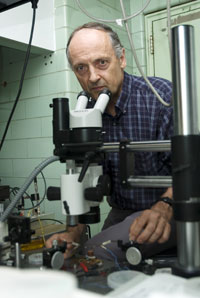  |
| HOME | THIS ISSUE | CALENDAR | GRANTS | BACK ISSUES | < BACK | NEXT > |
Researcher’s microchip technology could revolutionize electrical systemsby Michael Kirk - September 19, 2005 |
||||
|
A UConn researcher will soon enter the demonstration phase of a new microchip technology that he predicts will revolutionize electrical systems in everything from computers to cell phones to missiles. Nearly all such devices operate using only electrical signals. Typically, optoelectronic devices such as lasers (devices that generate light) and detectors (devices that sense light) operate with optical inputs and outputs, and may be combined with each other, but may not be combined with other high-performance electronics. This means that the advantages of optical signals are not available within conventional integrated circuits. Geoffrey Taylor, a professor of electrical and computer engineering, will soon complete work that integrates both light-generating and light-detecting functions into a single chip of semiconductor, replacing the connections now limiting the interconnection speed with optical links that use substantially less power. Relieving the power budget will enable higher speed chips and greater complexity to be used in the systems within the chip. “The optical links require much less power, so much higher speed chips are possible, which translates to higher speed systems,” Taylor says. “The interchangeability of electrical and optical signals will change the way in which circuits and systems are designed.” Current mainstream electronic integrated circuit technology is composed of transistors in the form of complementary pairs, he notes: “There is a much smaller subset of integrated circuits that integrates only optical devices composed of lasers, modulators, and passive optical waveguides. The new invention bridges the gap by integrating both device types. Thus it integrates complementary digital and analog electronic circuits with optoelectronic lasers and detectors. The set of devices invented include a natural semiconductor switch that functions as both a laser and a detector, and has significantly enhanced frequency performance translating to higher performance communications and computing.” This is no small feat. Taylor, a native of Canada, has been working on the research for more than 20 years, since he was at Bell Laboratories in New Jersey, and it has cost approximately $10 million to develop. He has been at UConn since 1994.
“During the late ’80s and early ’90s, key demonstrations were made at Bell Labs,” he says.“However, further inventions were necessary, and a practical demonstration required a laboratory facility. It took more than 10 years at UConn to build a lab and acquire the equipment and expertise to achieve the demonstration. During this time, the final innovations were made.” Taylor’s work is considered groundbreaking because so many different systems rely on electrical and optical devices to function, including aircraft, which are filled with masses of wiring to connect their various systems. Many of their functions could be replaced with fibers or waveguides coupled to Taylor’s small microchip. The same is true with computer towers, which would be a fraction of their size and capable of significantly more speed using reduced power once Taylor’s work is incorporated. The critical – and essential – element of Taylor’s work is creating a laser to function within his new chip. “To provide optical interconnect within the integrated circuit cost-effectively requires the laser to be integrated,” he says. “Without the laser, the whole concept falls apart, because then, optical signals would not be available in a manufacturable way. The ability to realize the laser together with complementary electronics is essential.” |
| ADVANCE HOME UCONN HOME |

